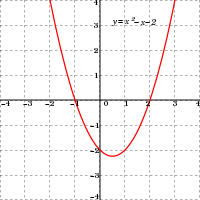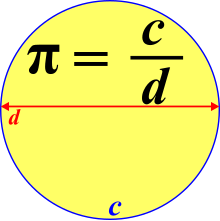
A | B | C | D | E | F | G | H | CH | I | J | K | L | M | N | O | P | Q | R | S | T | U | V | W | X | Y | Z | 0 | 1 | 2 | 3 | 4 | 5 | 6 | 7 | 8 | 9

Elementary algebra, also known as college algebra,[1] encompasses the basic concepts of algebra. It is often contrasted with arithmetic: arithmetic deals with specified numbers,[2] whilst algebra introduces variables (quantities without fixed values).[3]
This use of variables entails use of algebraic notation and an understanding of the general rules of the operations introduced in arithmetic: addition, subtraction, multiplication, division, etc. Unlike abstract algebra, elementary algebra is not concerned with algebraic structures outside the realm of real and complex numbers.
It is typically taught to secondary school students and at introductory college level in the United States,[4] and builds on their understanding of arithmetic. The use of variables to denote quantities allows general relationships between quantities to be formally and concisely expressed, and thus enables solving a broader scope of problems. Many quantitative relationships in science and mathematics are expressed as algebraic equations.
Algebraic operations

In mathematics, a basic algebraic operation is any one of the common operations of elementary algebra, which include addition, subtraction, multiplication, division, raising to a whole number power, and taking roots (fractional power).[5] These operations may be performed on numbers, in which case they are often called arithmetic operations. They may also be performed, in a similar way, on variables, algebraic expressions,[6] and more generally, on elements of algebraic structures, such as groups and fields.[7] An algebraic operation may also be defined simply as a function from a Cartesian power of a set to the same set.[8]
The term algebraic operation may also be used for operations that may be defined by compounding basic algebraic operations, such as the dot product. In calculus and mathematical analysis, algebraic operation is also used for the operations that may be defined by purely algebraic methods. For example, exponentiation with an integer or rational exponent is an algebraic operation, but not the general exponentiation with a real or complex exponent. Also, the derivative is an operation that is not algebraic.Algebraic notation
Algebraic notation describes the rules and conventions for writing mathematical expressions, as well as the terminology used for talking about parts of expressions. For example, the expression has the following components:

A coefficient is a numerical value, or letter representing a numerical constant, that multiplies a variable (the operator is omitted). A term is an addend or a summand, a group of coefficients, variables, constants and exponents that may be separated from the other terms by the plus and minus operators.[9] Letters represent variables and constants. By convention, letters at the beginning of the alphabet (e.g. ) are typically used to represent constants, and those toward the end of the alphabet (e.g. and z) are used to represent variables.[10] They are usually printed in italics.[11]
Algebraic operations work in the same way as arithmetic operations,[12] such as addition, subtraction, multiplication, division and exponentiation,[13] and are applied to algebraic variables and terms. Multiplication symbols are usually omitted, and implied when there is no space between two variables or terms, or when a coefficient is used. For example, is written as , and may be written .[14]
Usually terms with the highest power (exponent), are written on the left, for example, is written to the left of x. When a coefficient is one, it is usually omitted (e.g. is written ).[15] Likewise when the exponent (power) is one, (e.g. is written ).[16] When the exponent is zero, the result is always 1 (e.g. is always rewritten to 1).[17] However , being undefined, should not appear in an expression, and care should be taken in simplifying expressions in which variables may appear in exponents.
Alternative notation
Other types of notation are used in algebraic expressions when the required formatting is not available, or can not be implied, such as where only letters and symbols are available. As an illustration of this, while exponents are usually formatted using superscripts, e.g., , in plain text, and in the TeX mark-up language, the caret symbol ^ represents exponentiation, so is written as "x^2".[18][19] This also applies to some programming languages such as Lua. In programming languages such as Ada,[20] Fortran,[21] Perl,[22] Python[23] and Ruby,[24] a double asterisk is used, so is written as "x**2". Many programming languages and calculators use a single asterisk to represent the multiplication symbol,[25] and it must be explicitly used, for example, is written "3*x".
Concepts
Variables

Elementary algebra builds on and extends arithmetic[26] by introducing letters called variables to represent general (non-specified) numbers. This is useful for several reasons.
- Variables may represent numbers whose values are not yet known. For example, if the temperature of the current day, C, is 20 degrees higher than the temperature of the previous day, P, then the problem can be described algebraically as .[27]
- Variables allow one to describe general problems,[4] without specifying the values of the quantities that are involved. For example, it can be stated specifically that 5 minutes is equivalent to seconds. A more general (algebraic) description may state that the number of seconds, , where m is the number of minutes.
- Variables allow one to describe mathematical relationships between quantities that may vary.[28] For example, the relationship between the circumference, c, and diameter, d, of a circle is described by .
- Variables allow one to describe some mathematical properties. For example, a basic property of addition is commutativity which states that the order of numbers being added together does not matter. Commutativity is stated algebraically as .[29]
Simplifying expressions
Algebraic expressions may be evaluated and simplified, based on the basic properties of arithmetic operations (addition, subtraction, multiplication, division and exponentiation). For example,
- Added terms are simplified using coefficients. For example, can be simplified as (where 3 is a numerical coefficient).
- Multiplied terms are simplified using exponents. For example, is represented as
Antropológia
Aplikované vedy
Bibliometria
Dejiny vedy
Encyklopédie
Filozofia vedy
Forenzné vedy
Humanitné vedy
Knižničná veda
Kryogenika
Kryptológia
Kulturológia
Literárna veda
Medzidisciplinárne oblasti
Metódy kvantitatívnej analýzy
Metavedy
Metodika
Text je dostupný za podmienok Creative
Commons Attribution/Share-Alike License 3.0 Unported; prípadne za ďalších
podmienok.
Podrobnejšie informácie nájdete na stránke Podmienky
použitia.
www.astronomia.sk | www.biologia.sk | www.botanika.sk | www.dejiny.sk | www.economy.sk | www.elektrotechnika.sk | www.estetika.sk | www.farmakologia.sk | www.filozofia.sk | Fyzika | www.futurologia.sk | www.genetika.sk | www.chemia.sk | www.lingvistika.sk | www.politologia.sk | www.psychologia.sk | www.sexuologia.sk | www.sociologia.sk | www.veda.sk I www.zoologia.sk

























